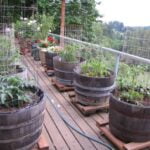Growing vegetables in small gardens can be a challenge, but with the right techniques and strategies, it is entirely possible to maximize space and create a thriving vegetable garden. This article explores various space-saving techniques for growing vegetables in small gardens, including compact and vertical growing options, container gardening, trellising and staking, companion planting, square foot gardening, utilizing vertical space, and tips for success.
When it comes to small gardens, every inch of space counts. Choosing the right vegetables and maximizing space with compact and vertical growing options can make a significant difference in the success of your garden. Additionally, container gardening using pots, hanging baskets, and raised beds can also be a game-changer for those dealing with limited space.
Supporting vertical growth through trellising and staking can help make the most of small areas by encouraging vining vegetables to grow upward instead of spreading out horizontally. Companion planting and intercropping techniques are also effective ways to maximize garden space while promoting healthy growth for your vegetable plants. With the right approach and strategies, even the smallest of gardens can yield abundant harvests of fresh produce.
Choosing the Right Vegetables
When it comes to growing vegetables in small gardens, choosing the right vegetables is essential for maximizing space. Compact and vertical growing options are key to making the most of limited garden space. With the right selection of vegetables, even the smallest garden can yield an abundant harvest.
Compact Varieties
One of the best ways to maximize space in a small garden is by choosing compact varieties of vegetables. Many vegetable varieties have been bred specifically for small spaces, such as patio tomatoes, dwarf beans, and mini bell peppers. These compact plants take up less room but still produce a bountiful harvest, making them ideal for small gardens.
Vertical Growing Options
In addition to compact varieties, vertical growing options can also help maximize space in a small garden. Vining vegetables such as cucumbers, peas, and squash can be trained to grow vertically on trellises or arbors, taking advantage of the upward space in the garden. This not only saves ground space but also allows for better air circulation and easier harvesting.
Succession Planting
Another space-saving technique when choosing vegetables for a small garden is succession planting. Instead of planting all of your crops at once, stagger your plantings so that new crops can be planted as soon as old ones are finished. This allows you to make the most of your available space and ensures a continuous harvest throughout the growing season.
By carefully selecting compact varieties, exploring vertical growing options, and implementing succession planting techniques, even the smallest vegetable gardens can be incredibly productive. With some thoughtful planning and strategic choices, anyone can enjoy a thriving vegetable garden regardless of limited space.
Container Gardening
Choosing the Right Containers
When it comes to container gardening in small spaces, choosing the right containers is crucial. Opt for pots, hanging baskets, and raised beds that are not only functional but also aesthetically pleasing. Consider the size and depth of the containers based on the vegetables you plan to grow. Additionally, ensure that the containers have proper drainage to prevent waterlogging.
Strategic Placement and Arrangement
In a small garden or balcony, every inch of space counts. When utilizing pots, hanging baskets, and raised beds for growing vegetables, strategic placement and arrangement are essential. Grouping similar types of plants together can help optimize space and make maintenance more efficient. Additionally, consider using vertical shelving or tiered stands to elevate some of the containers and make the most of limited ground space.
Soil and Maintenance
In container gardening, the quality of soil is paramount for the success of your vegetables. Use a high-quality potting mix that provides adequate nutrients and drainage for your plants. Regular maintenance such as watering, fertilizing, and monitoring for pests is also crucial in container gardening. Since containers may dry out more quickly than traditional garden beds, it’s important to be vigilant about maintaining optimal growing conditions for your vegetables.
By utilizing pots, hanging baskets, and raised beds strategically in small spaces, you can effectively create a bountiful vegetable garden even with limited room. These space-saving techniques allow individuals with small gardens or urban balconies to enjoy fresh produce without sacrificing precious outdoor space.
Trellising and Staking
Vertical gardening techniques such as trellising and staking are essential for supporting the growth of vining vegetables in small gardens. These space-saving methods allow gardeners to make the most of their limited space, maximize sunlight exposure, and improve air circulation around the plants. Here are some tips for successfully implementing trellising and staking in your small vegetable garden:
1. Choose the Right Support: Depending on the type of vining vegetables you’re growing, you’ll need to select appropriate trellises or stakes. For example, tall and heavy crops like indeterminate tomatoes may require sturdy metal cages or wooden stakes, while lightweight crops like peas and beans can thrive with simple trellises made of bamboo or twine.
2. Proper Installation: Make sure to install your trellises or stakes securely in the ground to prevent them from toppling over under the weight of growing plants or during strong winds. Additionally, position them in a way that allows easy access for pruning, harvesting, and maintenance.
3. Training the Plants: As your vining vegetables grow, gently train them to climb up the trellis or stake using soft ties or twine. This not only keeps the plants organized and prevents tangling but also promotes vertical growth, which helps save precious ground space.
By utilizing these trellising and staking techniques, you can effectively support the vertical growth of vining vegetables and optimize space in your small garden. With proper planning and care, you can enjoy a bountiful harvest even in limited areas.
Companion Planting
One of the most effective space-saving techniques for growing vegetables in small gardens is companion planting. This technique involves planting different types of plants together to maximize space, improve soil health, and deter pests. By carefully selecting which plants to grow together, gardeners can make the most of their limited space while also benefiting from the symbiotic relationships between certain plant species.
For small gardens, intercropping is a great way to make efficient use of limited space. This involves planting different crops in the same area at the same time, allowing for optimal use of space and resources. For example, fast-growing and shallow-rooted crops can be planted alongside taller, deeper-rooted plants to make use of the entire garden space. This not only maximizes yield but also helps to prevent soil depletion and disease build-up.
Another key aspect of companion planting is utilizing plants that have mutually-beneficial relationships with each other. For example, planting aromatic herbs like basil or dill next to tomatoes can help repel pests that commonly affect tomato plants.
Similarly, planting nitrogen-fixing legumes like peas or beans alongside heavy feeders like corn can improve soil fertility and overall plant health. By strategically planning which plants to grow together, gardeners can effectively maximize their small garden space while promoting a healthy and productive vegetable garden.
Square Foot Gardening
When it comes to growing vegetables in small gardens, space-saving techniques are essential for maximizing the potential of your limited area. Square foot gardening is an efficient and organized method that allows you to grow a variety of vegetables in a small space. This technique involves dividing your garden into small square sections, typically 1 foot by 1 foot, and planting different crops in each section based on the recommended spacing for each plant.
One of the key benefits of square foot gardening is that it eliminates the need for traditional rows, allowing you to maximize every inch of available space. This method also makes it easier to manage and maintain your garden, as the smaller sections help prevent overcrowding and make it simpler to water, weed, and harvest your crops. Additionally, square foot gardening can be adapted to containers or raised beds, making it a versatile option for small gardens and urban environments.
For example, if you have a 4-foot by 4-foot raised bed, you would divide it into 16 individual squares. Each square would then be planted with a different vegetable or a specific number of plants based on their recommended spacing. This approach not only ensures efficient use of space but also makes it easier to plan and organize your garden throughout the growing season.
| Vegetable | Number of Squares |
|---|---|
| Tomatoes | 2 |
| Carrots | 1 |
| Lettuce | 4 |
Utilizing Vertical Space
One space-saving technique for utilizing vertical space is to install trellises or stakes for climbing plants such as cucumbers, peas, and pole beans. These plants naturally climb upwards, so by providing them with support, you can prevent them from sprawling across the ground and instead encourage them to grow vertically. This strategy not only saves space but also makes harvesting and maintenance much easier.
Another way to maximize vertical space is by using hanging baskets or wall-mounted planters. Many vegetables, including cherry tomatoes, lettuce, and peppers, thrive in containers and hanging planters. By hanging these planters on walls or fences, you can create a lush garden while keeping the ground free for other crops or outdoor activities. Additionally, using raised beds against walls or fences can provide extra planting area while maintaining an organized and visually appealing garden layout.
Furthermore, consider growing vining vegetables such as squash and melons on sturdy trellises attached to walls or fences. These large-fruited plants can take up a considerable amount of ground space if left to sprawl but can be trained to grow vertically with proper support. By doing so, you’ll not only save space but also improve air circulation around the plants, reducing the risk of diseases.
| Vertical Gardening Technique | Vegetables Suitable for Vertical Growth |
|---|---|
| Trellising or Staking | Cucumbers, Peas, Pole Beans |
| Hanging Baskets/Wall Planters | Cherry Tomatoes, Lettuce, Peppers |
| Vining Vegetables on Trellises | Squash, Melons |
Tips for Success
In conclusion, growing vegetables in small gardens can be challenging, but with the right techniques and strategies, it is definitely possible to have a bountiful harvest even in limited space. By choosing compact and vertical growing options, utilizing container gardening, trellising and staking, companion planting, square foot gardening, and making use of vertical space on walls, fences, and arbors, gardeners can maximize every inch of their small garden.
One of the most important factors for success in small-space vegetable gardens is proper maintenance, watering, and fertilization. Regular maintenance such as weeding, pruning, and inspecting for pests and diseases is crucial to the health of the plants. Watering must be done carefully to ensure that the plants receive adequate moisture without waterlogging the soil. Additionally, using a good quality fertilizer or compost can help provide essential nutrients to the vegetables for healthy growth.
Frequently Asked Questions
How Can I Save Space in My Vegetable Garden?
One way to save space in your vegetable garden is by using vertical gardening techniques. This allows you to grow plants upwards instead of outwards, maximizing the use of space. Additionally, planting in raised beds or containers can help optimize space and organization.
How Do You Grow a Lot of Vegetables in a Small Space?
Growing a lot of vegetables in a small space requires careful planning and strategic planting. Utilize intercropping, which involves planting different crops together that benefit each other. You can also use succession planting to maximize the yield from one space by planting new crops as others are harvested.
How Do You Maximize Space in a Small Garden?
To maximize space in a small garden, consider using trellises or stakes for vining plants like cucumbers or tomatoes. These structures allow the plants to grow vertically instead of taking up valuable ground space. Additionally, try square foot gardening to efficiently organize and utilize the available space for different types of vegetables.

If you’re looking to get into vegetable gardening, or are just looking for some tips on how to make your current garden better, then you’ve come to the right place! My name is Ethel and I have been gardening for years. In this blog, I’m going to share with you some of my best tips on how to create a successful vegetable garden.





